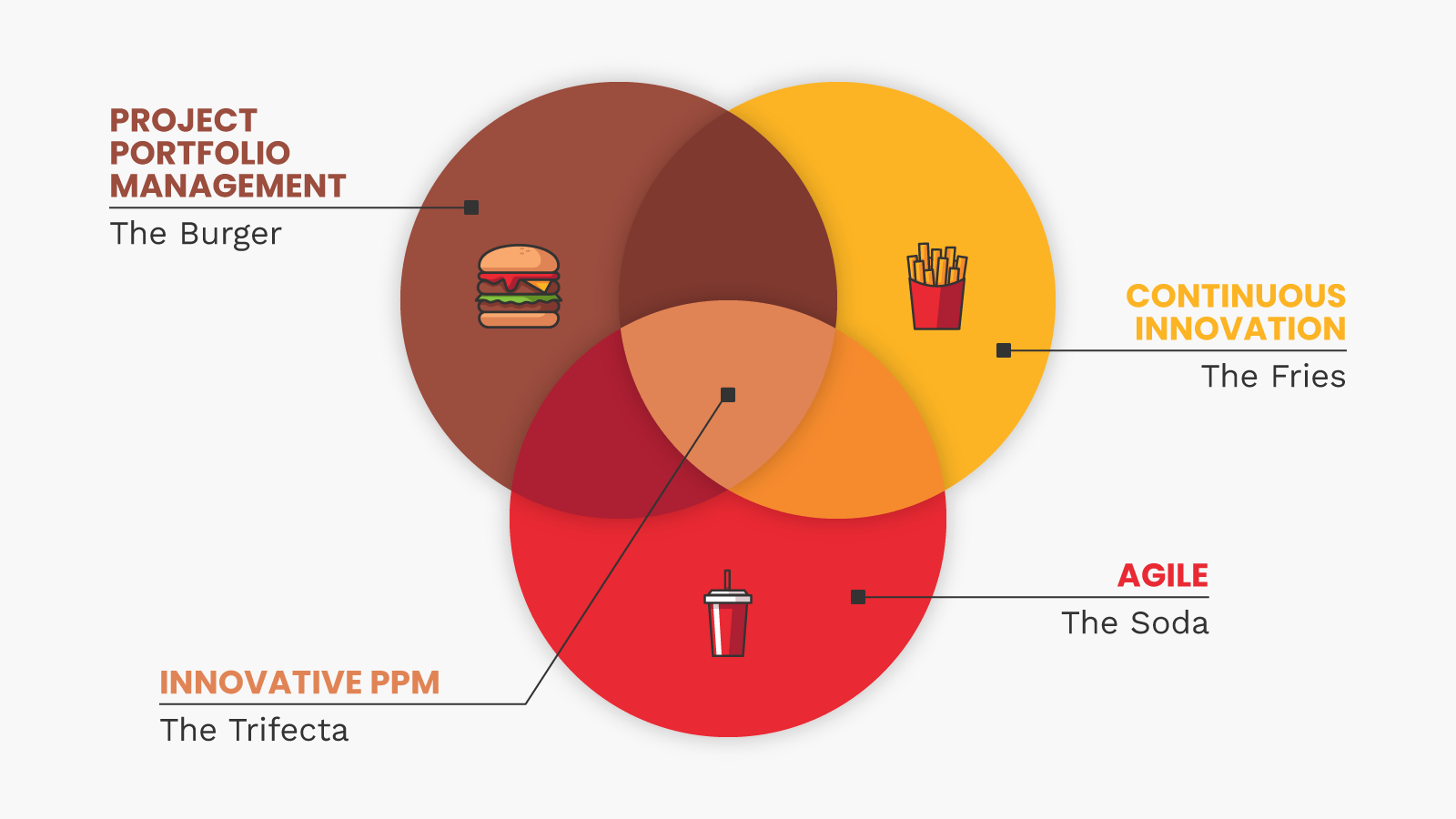This article received the 2020 Business Innovation Brief Most Valuable Post Award in the Innovation Strategies category.
Would you like fries with that? You were probably asked this question at some point or another while ordering a hamburger—and for good reason, too. After all, what goes better with a mouthwatering burger than some golden-crispy french fries? It’s a match made in heaven. But if you’re seeking eternal bliss, then you will likely top it off with a refreshing soft drink, because let’s face it: burger, fries and soda are the ultimate trifecta of fun, fast food.
When it comes to the trifecta of innovative Project Portfolio Management (PPM), PPM, Continuous Innovation and Agile come together to create a complete framework for innovation success. Think of PPM as your burger, Continuous Innovation as your fries, and Agile as your soda; sure, you can have each one on their own, but they work so much better when combined.
Project Portfolio Management – The Burger
PPM practice is the meat of the matter, as it ensures project portfolios are properly managed, prioritized, tracked, reported and aligned with business strategy. This is achieved by standardizing processes, managing risk and allocating resources accordingly; but as the number of projects inevitably grows and resources get stretched, the Project Management Office (PMO) is left with the increasingly difficult task of making strategically aligned investments that deliver successful business outcomes. According to Gartner, the innovative PMO must reinvent processes, embrace new ideas and invest in adaptive approaches that support the digital efforts of the business, or risk getting left behind. This is where Continuous Innovation comes in.
Continuous Innovation – The Fries
Continuous Innovation is the golden ticket to sustainable growth. In its 2020 research report on innovation management platforms, Forrester states that continuous innovation for customer-obsessed firms is a modern business imperative to stay ahead, which makes innovation management all the more fitting for the PMO’s systems-driven approach to best practices, work processes and automation. This is because innovation management serves as the gateway to a world of actionable insights that empower an organization’s innovation ecosystem to identify and collaborate on the best ideas that are strategically aligned with company objectives and that add value throughout the project lifecycle. To this extent, portfolio management and innovation management, much like burgers and fries, are complementary, and the sustainable organization will leverage both systems to improve portfolio quality and ensure the proper management of its innovation activities. However, as the 2020 State of Corporate Innovation Report by Planbox reveals, 72% of PMOs are not involved in innovation projects. This is where Agile comes in.
Agile – The Soda
For all intents and purposes, Agile is the carbonated soft drink that simply makes everything go down easier. Implementing mature Agile practices at higher rates enables organizations to maximize customer value and deliver results faster and with greater efficiency, as they are better equipped to handle midcourse corrections without sacrificing project quality in the face of fluctuating demands. It is therefore crucial for the innovative PMO to embed Agile Innovation in its efforts to lead digital transformation across the enterprise. Research conducted by MIT (Massachusetts Institute of Technology) reveals that Agile innovating organizations grow revenue 37% faster and generate 30% higher profits compared to their non-Agile counterparts. It’s no surprise then that Gartner predicts Agile will become the dominant approach to project management for effective enterprise change and outcomes by 2023.
The future of work is unfolding before our eyes like paper uncrinkling from a freshly wrapped burger. What organizations need more than ever to achieve long-term growth is a complete framework for Continuous Innovation that is internalized and integrated in the standard operating procedures of the enterprise, for which the IPMO (Innovative Project Management Office) is uniquely positioned to lead as it takes on Agile practices and digital efforts across the organization—the only question now is: would you like innovation with that?

Lucas Potasso-Justino
Chief Editor for the Future-Fit Manifesto. I Inspire people to push beyond their limitations to bring about the organizational change they desire and deserve. Follow me LinkedIn.

